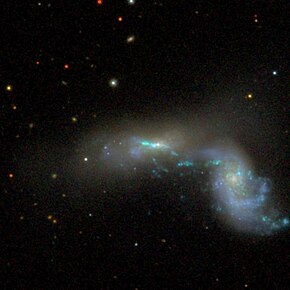
NGC 7130 is a spiral galaxy located in the constellation Piscis Austrinus. It is located at a distance of about 220 million light years from Earth, which, given its apparent dimensions, means that NGC 7130 is about 100,000 light years across. It was discovered by John Herschel on September 25, 1834, and discovered independently by Lewis Swift on September 17, 1897. The location of the galaxy given in the New General Catalogue was off by 30 arcminutes in declination from the location of the galaxy.

NGC 6907 is a spiral galaxy located in the constellation Capricornus. It is located at a distance of about 120 million light-years from Earth, which, given its apparent dimensions, means that NGC 6907 is about 115,000 light-years across. It was discovered by William Herschel on July 12, 1784. The total infrared luminosity of the galaxy is 1011.03 L☉, and thus it is categorised as a luminous infrared galaxy.

NGC 753 is a spiral galaxy located 220 million light-years away in the constellation Andromeda. The galaxy was discovered by astronomer by Heinrich d'Arrest on September 16, 1865 and is a member of Abell 262.

NGC 759 is an elliptical galaxy located 230 million light-years away in the constellation Andromeda. NGC 759 was discovered by astronomer by Heinrich d'Arrest on September 17, 1865. It is a member of Abell 262.

NGC 3665 is a lenticular galaxy located in the constellation Ursa Major. It is located at a distance of circa 85 million light-years from Earth, which, given its apparent dimensions, means that NGC 3665 is about 85,000 light years across. It was discovered by William Herschel on March 23, 1789.
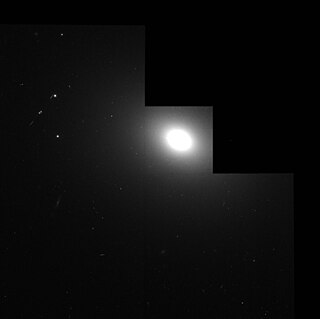
IC 1459 is an elliptical galaxy located in the constellation Grus. It is located at a distance of circa 85 million light-years from Earth, which, given its apparent dimensions, means that IC 1459 is about 130,000 light-years across. It was discovered by Edward Emerson Barnard in 1892.

NGC 877 is an intermediate spiral galaxy located in the constellation Aries. It is located at a distance of circa 160 million light years from Earth, which, given its apparent dimensions, means that NGC 877 is about 115,000 light years across. It was discovered by William Herschel on October 14, 1784. It interacts with NGC 876.

NGC 691 is an unbarred spiral galaxy located in the constellation Aries. It is located at a distance of circa 120 million light years from Earth, which, given its apparent dimensions, means that NGC 691 is about 130,000 light years across. It was discovered by William Herschel on November 13, 1786.
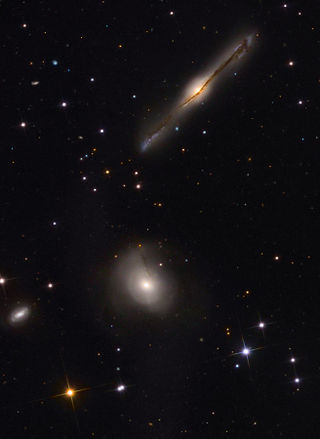
NGC 680 is an elliptical galaxy located in the constellation Aries. It is located at a distance of circa 120 million light years from Earth, which, given its apparent dimensions, means that NGC 680 is about 100,000 light years across. It was discovered by William Herschel on September 15, 1784.

NGC 973 is a giant spiral galaxy located in the constellation Triangulum. It is located at a distance of circa 200 million light-years from Earth, which, given its apparent dimensions, means that NGC 973 is about 230,000 light years across. It was discovered by Lewis Swift on October 30, 1885.
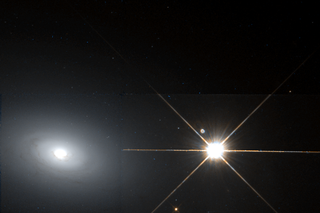
NGC 2974 is a lenticular galaxy located in the constellation Sextans. It is located at a distance of circa 90 million light years from Earth, which, given its apparent dimensions, means that NGC 2974 is about 90,000 light years across. It was discovered by William Herschel on January 6, 1785. NGC 2974 is located in the sky about 2 and a half degrees south-south east of Iota Hydrae and more than 6 degrees northeast of Alphard. A 10th magnitude star lies next to the galaxy, thus making it a challenging object at low magnifications. NGC 2974 is part of the Herschel 400 Catalogue.
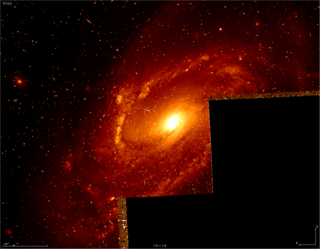
NGC 1241 is a spiral galaxy located in the constellation Eridanus. It is located at a distance of circa 150 million light years from Earth, which, given its apparent dimensions, means that NGC 1241 is about 140,000 light years across. It was discovered by William Herschel on January 10, 1785. It is classified as a Seyfert galaxy.

NGC 4324 is a lenticular galaxy located about 85 million light-years away in the constellation Virgo. It was discovered by astronomer Heinrich d'Arrest on March 4, 1862. NGC 4324 has a stellar mass of 5.62 × 1010M☉, and a baryonic mass of 5.88 × 1010M☉. The galaxy's total mass is around 5.25 × 1011M☉. NGC 4324 is notable for having a ring of star formation surrounding its nucleus. It was considered a member of the Virgo II Groups until 1999, when its distance was recalculated and it was placed in the Virgo W Group.

The Leo II Groups, or Leo II Cloud, are a series of at least 110 galactic clusters and individual galaxies stretching approximately 30 Mly ecliptic west of the edge of the Virgo cluster. It is located approximately 65 Mly to 95 Mly from the Solar System, at a right ascension of 10h 00m to 11h 40m.
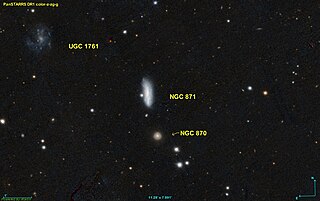
NGC 871 is a barred spiral galaxy in the Aries constellation. Its discovery and first description was realized by William Herschel on October 14, 1784 and the findings made public through his Catalogue of Nebulae and Clusters of Stars in 1786.

NGC 2445 is a peculiar ring galaxy in the constellation Lynx. The galaxy lies about 200 million light years away from Earth, which means, given its apparent dimensions, that NGC 2445 is approximately 100,000 light years across. It was discovered by Édouard Stephan on January 18, 1877. The galaxy interacts with another galaxy, NGC 2444, and as a result its shape is distorted and new stars are formed.

NGC 5953 is a peculiar spiral galaxy in the constellation Serpens. The galaxy lies about 80 million light years away from Earth, which means, given its apparent dimensions, that NGC 5953 is approximately 35,000 light years across. It was discovered by William Herschel on April 17, 1784. NGC 5953 interacts with NGC 5954 forming a pair known as Arp 91.

NGC 3395 is a peculiar spiral galaxy in the constellation Leo Minor. The galaxy lies about 55 million light years away from Earth, which means, given its apparent dimensions, that NGC 3395 is approximately 35,000 light years across. It was discovered by William Herschel on December 7, 1785. NGC 3395 interacts with NGC 3396.
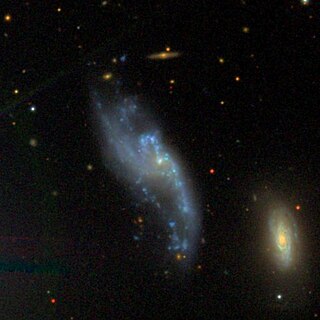
NGC 3995 is a Magellanic spiral galaxy in the constellation Ursa Major. The galaxy lies about 100 million light years away from Earth based on the Tully–Fisher relation, which means, given its apparent dimensions, that NGC 3995 is approximately 80,000 light years across, while based on redshift it lies 170 million light years away. It was discovered by Heinrich d'Arrest on February 5, 1864.

NGC 3994 is a spiral galaxy in the constellation Ursa Major. The galaxy lies about 160 million light years away from Earth, which means, given its apparent dimensions, that NGC 3994 is approximately 70,000 light years across. It was discovered by Heinrich d'Arrest on April 6, 1864.
